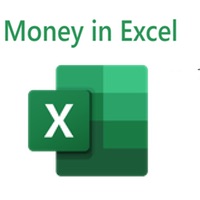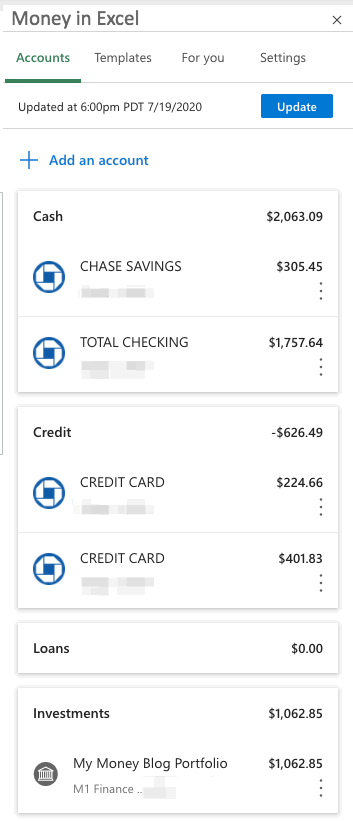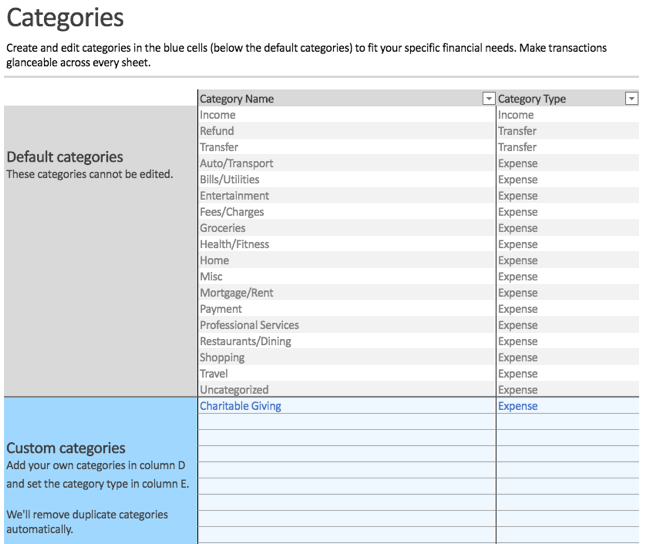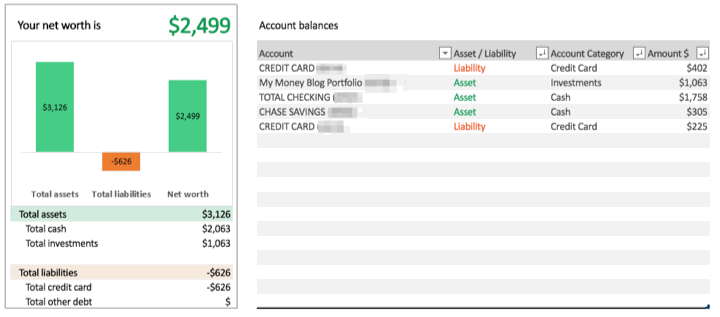 Thanks to generous assistance from a reader, I was able to spend some time poking around the new Money in Excel template for Microsoft 365 Personal or Family subscribers. Does it fulfill its promise of helping you “see all your financial accounts in one place, make a plan, and reach your financial goals”? Here’s my rundown of the features that were included and those that were missed.
Thanks to generous assistance from a reader, I was able to spend some time poking around the new Money in Excel template for Microsoft 365 Personal or Family subscribers. Does it fulfill its promise of helping you “see all your financial accounts in one place, make a plan, and reach your financial goals”? Here’s my rundown of the features that were included and those that were missed.
Accounts Toolbar. After following the clear installation instructions, you can add your various financial accounts using the toolbar on the right-hand side. (I just connected a few secondary accounts for review purposes.) Plaid is used for account aggregation, where you provide your login and passwords and they use that to grab your account balances and transaction history. This data import feeds the rest of the Excel worksheet, but the panel itself is a useful at-a-glance snapshot of your finances. The feel is very similar to the “Overview” page on the Intuit Mint app.

Customized Categories. In the “Categories” worksheet, you can create and edit the names of custom categories used to organize your transactions. For example, I added “Charitable Giving”. You can’t edit the original, default categories.

Transactions. You then move onto the “Transactions” worksheet, where you can edit the categories assigned to each specific imported transaction. If you have a lot of transactions across different bank and credit card accounts, this provides a handy aggregate view of everything together.

Spending analysis. For the most part, this template is about budgeting and spending. Once have all your transactions imported and categories, it will generate some basic charts and provide some simple insights into your expenses. Here are some examples:
- Spending breakdown by category
- Current vs. previous month spending
- Cumulative spending over the month
- Net worth calculation (assets minus liabilities)
- Top merchant: Where did you spend the most money?
- Bank fees: How much are you paying in fees?
- Subscriptions: Where are your recurring expenses?

This is all useful for someone trying to understand their spending and developing their own budgeting system, but it’s definitely not groundbreaking. Mint.com has providing this type of service for many years. The main differences are that there are no pesky advertisements inside your own Excel worksheet, while the Mint smartphone app may be more convenient.
Missing: Holdings, asset allocation, performance tracking. I am able to connect to an investment account, but it only shows me the total dollar balance. That’s it, as far as I can tell. There is no data on individual holdings, no asset allocation breakdown, no performance tracking.
Missing: Investment transaction list. I am not able to see historical buy/sell transactions on a simple view-only basis, like on the credit card side. It would be nice just to see the last 10 transactions, for example.
There are other portfolio spreadsheets where you can manually input ticker symbols and share counts and they’ll pull in market quotes, but that doesn’t adjust for events like dividends, stock splits, and dividend reinvestment. I was hoping to create a single portfolio spreadsheet using the imported data cells from my brokerage accounts, one that would provide a live view of all my investment accounts, but also allow me to manipulate those data in order to determine if/when to rebalance my portfolio.
For now, I will have to stick with my existing system using both Personal Capital and a custom Google Spreadsheet to track my investment holdings. The Personal Capital financial tracking app (free, my review) automatically logs into my accounts, adds up my balances, tracks my performance, and calculates my asset allocation. Then, I use my manual Google Spreadsheet (free, instructions) to help me calculate how much I need in each asset class to rebalance back towards my target asset allocation.
Bottom line. The “Money in Excel” template for Microsoft 365 Family and Personal subscribers is a free, basic template that imports your spending transactions across different bank and credit card accounts. It can help you with monthly budgeting, but not much beyond that. I hope that in the future they expand it to investment accounts and allow you to have more control over your data. It would also be nice if they made it free for everyone with access to Excel, not just Microsoft 365 Family and Personal subscribers.
 The Best Credit Card Bonus Offers – 2025
The Best Credit Card Bonus Offers – 2025 Big List of Free Stocks from Brokerage Apps
Big List of Free Stocks from Brokerage Apps Best Interest Rates on Cash - 2025
Best Interest Rates on Cash - 2025 Free Credit Scores x 3 + Free Credit Monitoring
Free Credit Scores x 3 + Free Credit Monitoring Best No Fee 0% APR Balance Transfer Offers
Best No Fee 0% APR Balance Transfer Offers Little-Known Cellular Data Plans That Can Save Big Money
Little-Known Cellular Data Plans That Can Save Big Money How To Haggle Your Cable or Direct TV Bill
How To Haggle Your Cable or Direct TV Bill Big List of Free Consumer Data Reports (Credit, Rent, Work)
Big List of Free Consumer Data Reports (Credit, Rent, Work)
Jonathan,
I’ve been enjoying your blog for many years, but I don’t recall you ever mentioning that you’ve ever tried Microsoft Money Sunset (your last mention of it was back in 2010, when Microsoft announced they were discontinuing support of the program). Everything you find lacking in this Excel template, and the other programs you mention, is handled very nicely in MMS. Had you tried it out, as I had recommended back then, you would probably still be using it, as it is still superior to any other personal financial software in existence!
I enjoyed your review, if only to remind me that nothing else compares to MMS, and again, I refer you to my blog at https://microsoftmoneyoffline.wordpress.com/ to learn more.
I’m glad that Microsoft Money Sunset works for you. Thanks for maintaining a useful resource for others.
Now, if I am correct it still requires you to log into each account and download a .ofx file to import? Right now Personal Capital syncs everything automatically, and I just type in some balances from my Personal Cap dashboard into my Excel file and I’m done. Also, I use a Mac and using a Windows emulator would be more time and effort.
Again, I referred you to my blog, as the sticky (1st post) describes how to avoid manually getting quotes and statements. With Pocketsense, you run one script to gather all of your ofx/qfx files and automatically import them all into Money – just about as nicely as when Money was linked online with MSN servers.
Well I tried my best to sell you on it, but didn’t know you were a Mac user (I’ve always been a PC user).
Have you ever done a Quicken review? I continue to look for a good alternative to Quicken, but have not found one. Not free, but it allows me to do everything in one place.
I maintain that Microsoft Money Sunset is a much better alternative than Quicken. I tried out Quicken for 2 or 3 days, and went back!
The author of the data converter from Microsoft Money to Quicken , a few years back, is still using Money too, as he found Quicken to be very quirky.
Thank you for your input. I looked at your blog that was last updated in April 2018. Before Microsoft discontinued Money, I switched from Quicken to Money and found that Money was not as good for my needs as Quicken and switched back. I prefer to use software that is supported, so for now I will be staying with Quicken.
Thank you for your review. Is there an alternative for Apple’s Numbers app? Thanks!
Hi Jonathan. I also use Personal Capital for aggregating all of my investment accounts with different brokerage firms and everything is working well. I am grateful to learn about Microsoft Money in Excel template that you shared. Is it possible to use this Excel template without having to pay for Microsoft 365 subscription? The cost is $99 per year and I see myself only using one template. Paying $99/year seems a lot of money. Any workaround solution that doesn’t cost anything to use for managing budgets? (in the spirit of staying frugal.) Thanks again! I am a big fan of reading your blog.
I’m afraid that I am not aware of any workaround to having a Microsoft 365 Personal/Family subscription. Thanks for reading!
Dan Adkins, is there any way to contact you? Looked all over your blog. I agree 100% with you and have struggled with the (beyond horrible) Quicken for 10 years now after using Money since 1995. Curse the day in May 2011 that I converted to Quicken, I should have just downloaded in transactions by hand. And I’m a CPA! Anyhoodles, do you know of anyway to export out of Quicken and import into Money? Just simple stuff like date, payee, category, memo and amount would be enough. Thanks for maintaining your site/blog
Hi Joshua,
danadkins at msn dot com. If Quicken still lets you export qif files, you can create a Money file using this article as a guide:
https://microsoftmoneyoffline.wordpress.com/merging-money-files/